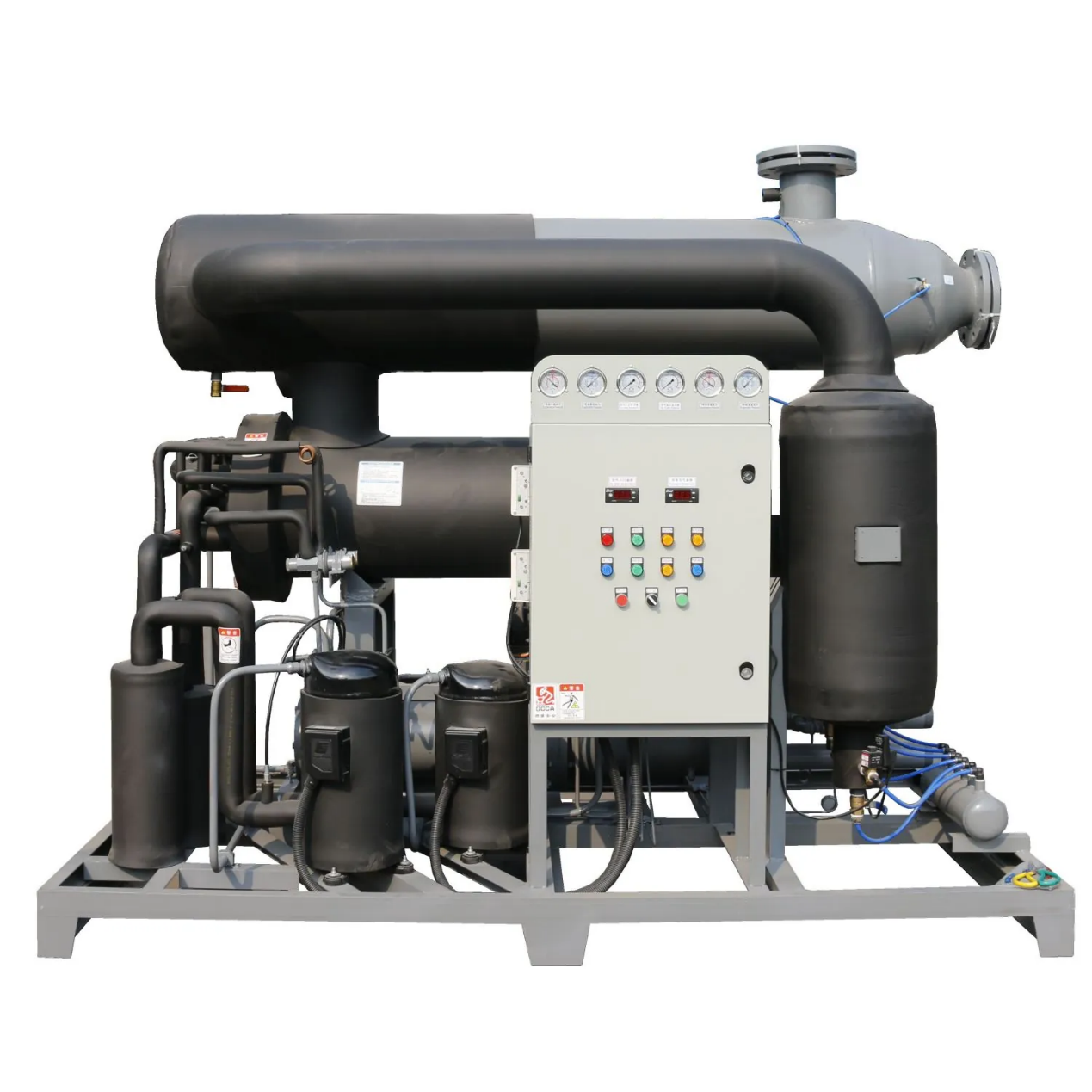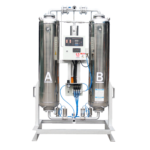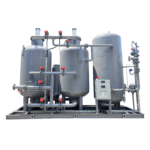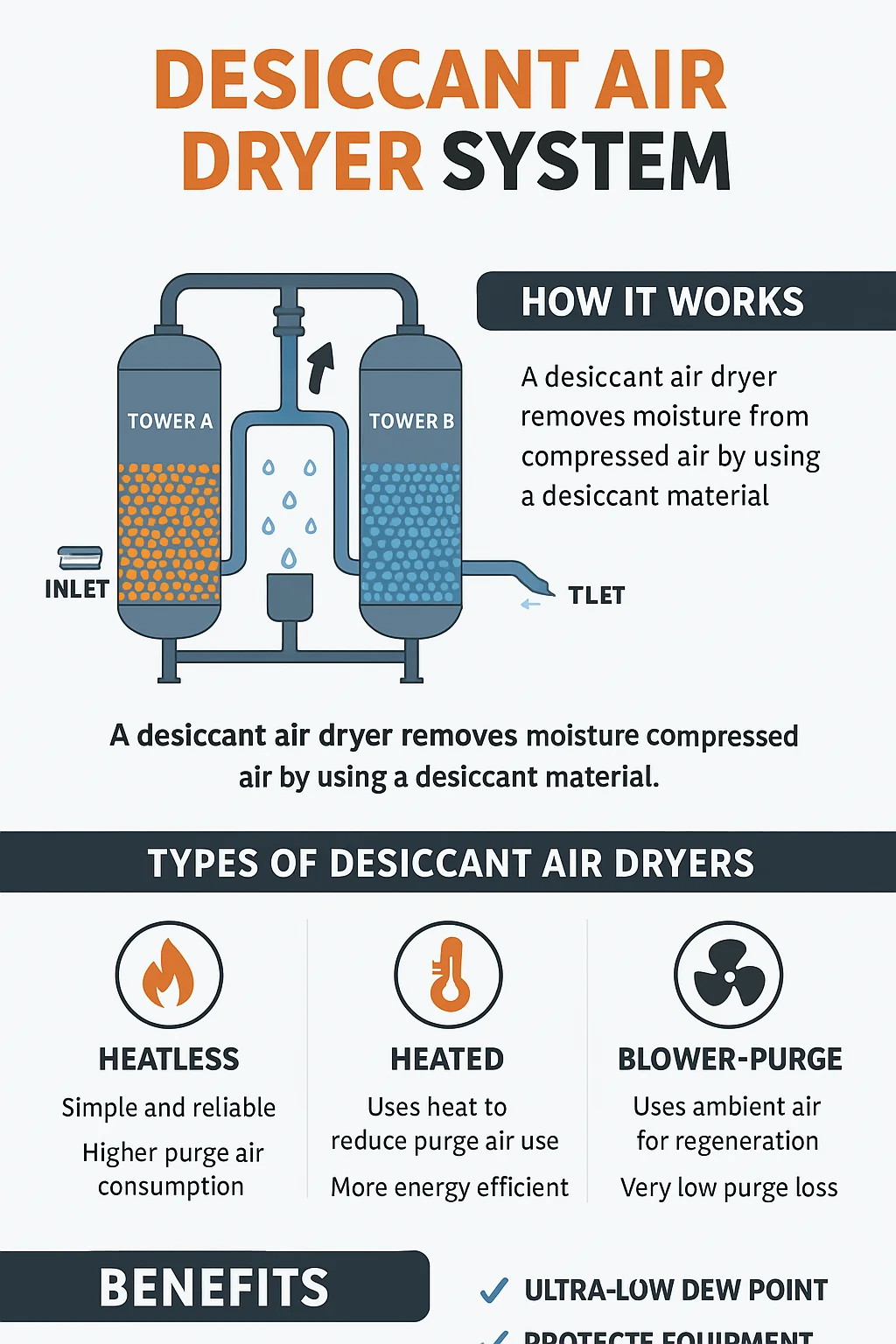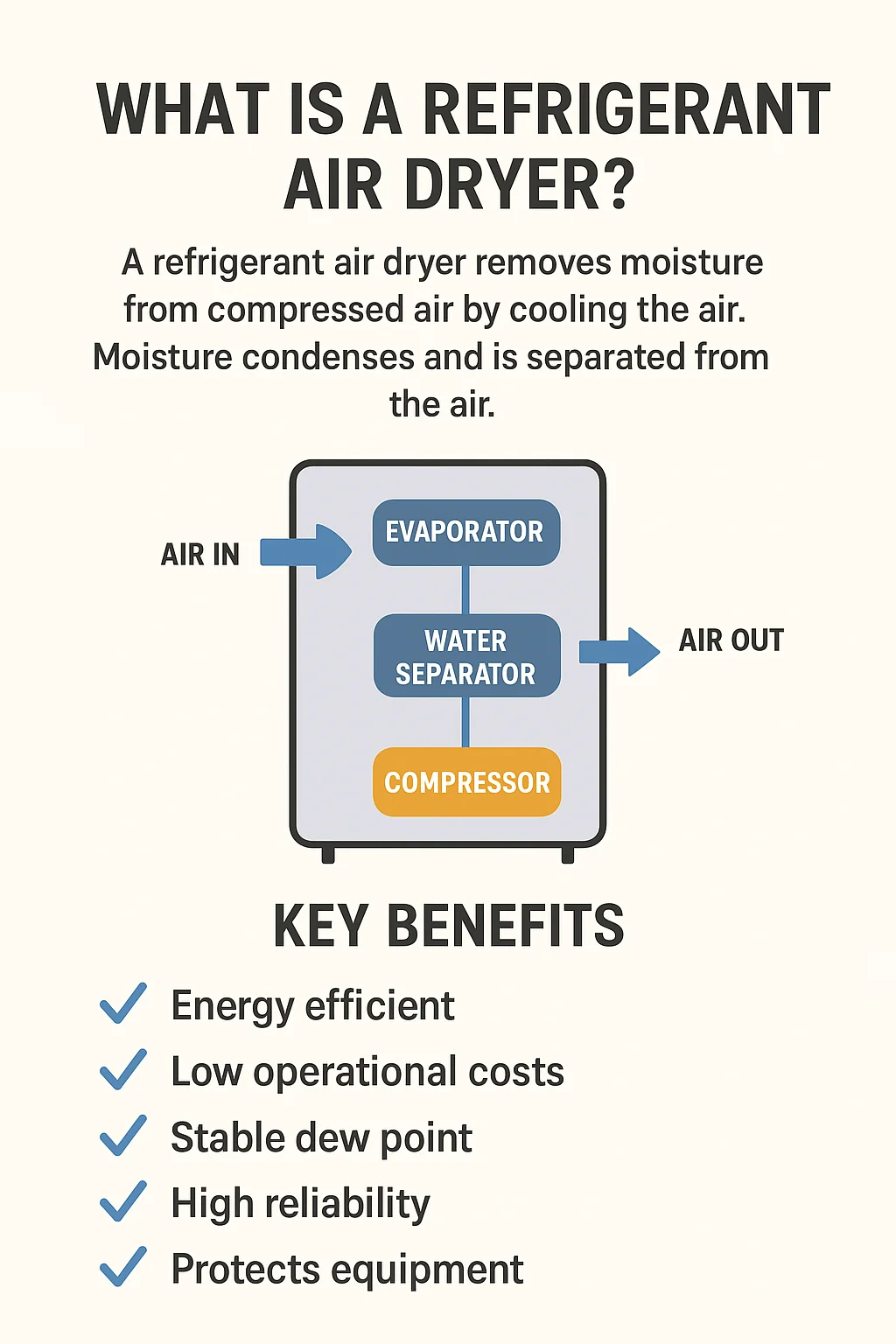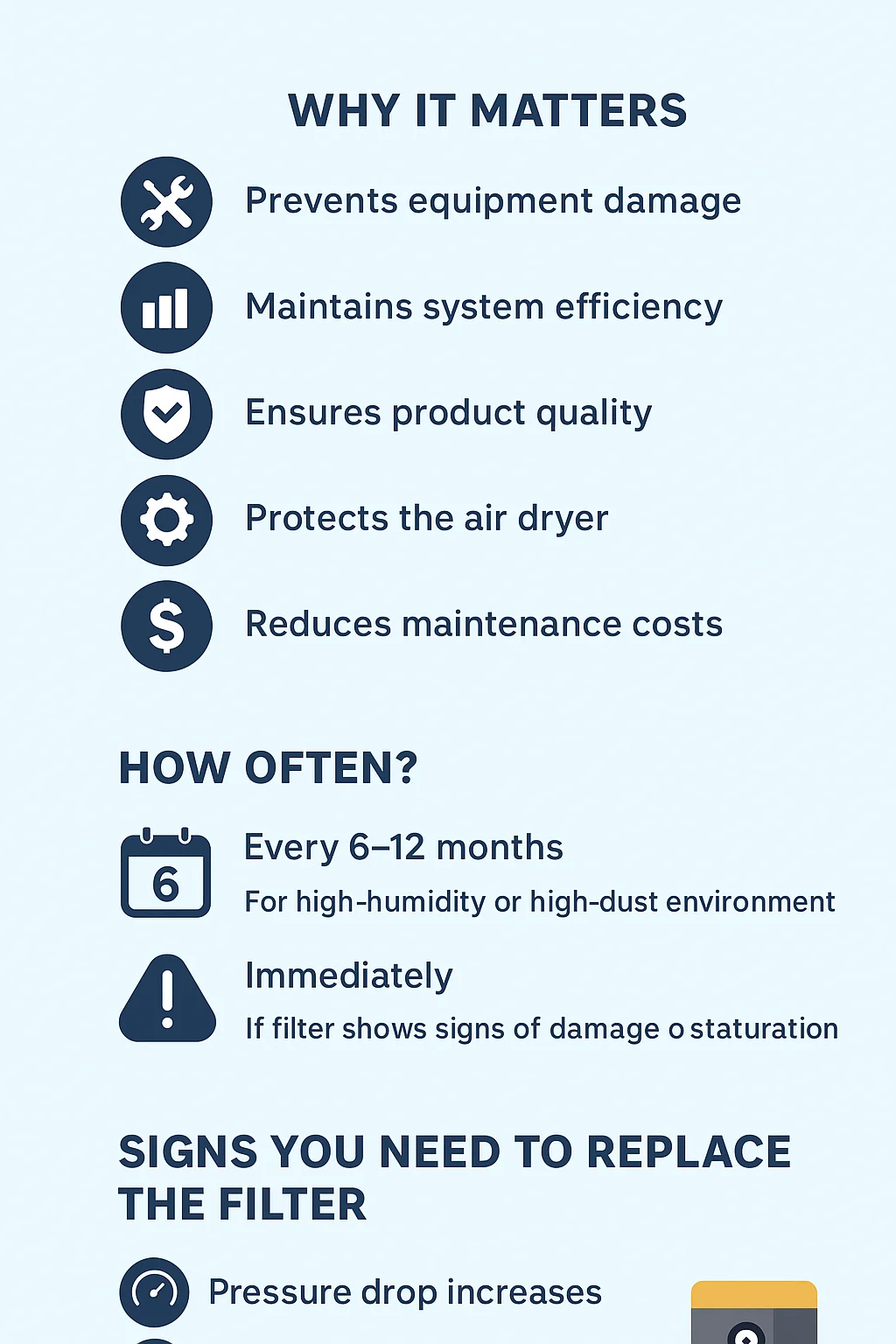Refrigerated compressed air dryers are essential devices used to remove moisture from compressed air systems. They play a critical role in ensuring that your compressed air is dry, clean, and safe for use in various industrial and commercial applications. Without a refrigerated compressed air dryer, moisture in the air can cause damage to equipment, reduce efficiency, and even contaminate products.
By cooling compressed air below its dew point, these dryers condense water vapor into liquid form, which can then be drained away, leaving clean, dry air. In this article, we will discuss refrigerated compressed air dryers, how they work, their benefits, and how to choose the right model for your needs.
How Do Refrigerated Compressed Air Dryers Work?
The operation of a refrigerated compressed air dryer is straightforward but highly effective. Here’s how it works:
Compressed Air Inlet – Compressed air enters the dryer, usually at high temperatures and containing water vapor.
Cooling Process – The air passes through a heat exchanger, where it is cooled by a refrigeration system. The cold air causes the moisture in the air to condense.
Moisture Separation – The condensed water is separated from the air using a moisture separator or drain.
Dry Air Outlet – The resulting dry air is then delivered to your tools, machinery, or production processes.
This simple but efficient process helps maintain air quality and protects sensitive equipment from damage caused by moisture buildup.
Benefits of Refrigerated Compressed Air Dryers
Choosing refrigerated compressed air dryers offers several key benefits for businesses that rely on compressed air systems:
Prevents Rust and Corrosion – Moisture in compressed air leads to rust and corrosion in pipes, tanks, and tools. A refrigerated dryer removes this moisture, extending the lifespan of your equipment.
Improves Product Quality – In industries such as food processing, pharmaceuticals, and electronics, clean and dry compressed air ensures better product quality and prevents contamination.
Reduces Maintenance Costs – Moisture and oil can damage machinery, causing expensive repairs and downtime. A refrigerated dryer helps avoid these issues, saving on repair costs.
Increases Efficiency – Dry air reduces energy consumption by preventing pressure losses and reducing the work your compressor needs to do.
Enhances Safety – Dry air reduces the risk of accidents related to water damage in pneumatic systems.
Applications of Refrigerated Compressed Air Dryers
Refrigerated compressed air dryers are used in a wide range of industries, including:
1. Manufacturing
In manufacturing environments, compressed air is often used for powering machines, tools, and automation. Moisture-free air ensures the machines run smoothly, reduces wear and tear, and prevents downtime.
2. Automotive
Automotive shops use compressed air for tools like pneumatic wrenches and sprayers. A refrigerated compressed air dryer keeps air clean and dry, ensuring tools perform reliably and paint jobs are smooth.
3. Food and Beverage
Compressed air in food production and packaging must be free from moisture to avoid contamination. Refrigerated compressed air dryers help meet hygiene standards, ensuring food safety.
4. Pharmaceuticals
In pharmaceutical manufacturing, clean and dry air is essential to maintain sterile conditions and meet regulatory standards. Refrigerated compressed air dryers ensure that air used in sensitive applications is moisture-free.
5. Electronics
In electronics manufacturing, moisture can damage components and circuits. Using a refrigerated compressed air dryer ensures that air used in assembly and cleaning processes remains dry and clean, avoiding defects.
How to Choose the Right Refrigerated Compressed Air Dryer
Choosing the right refrigerated compressed air dryer depends on several factors:
Airflow Capacity (CFM) – Ensure the dryer’s airflow capacity matches your compressor’s output.
Operating Pressure – Make sure the dryer is compatible with your compressed air system’s pressure.
Dew Point Requirements – Refrigerated air dryers typically provide a dew point of around 35-40°F (2-4°C), which is sufficient for most applications. If your application requires a lower dew point, you may need a desiccant dryer instead.
Energy Efficiency – Look for energy-efficient models that will help reduce operational costs. Some refrigerated dryers come with energy-saving features like cycling modes or low-pressure drop designs.
Maintenance Needs – Consider models with easy-to-access filters and automatic drain systems, reducing the time and cost of maintenance.
FAQ – Refrigerated Compressed Air Dryers
What is the difference between a refrigerated air dryer and a desiccant air dryer?
Refrigerated air dryers typically provide a dew point of 35-40°F, while desiccant dryers can achieve much lower dew points (as low as -40°F). Desiccant dryers are used for applications that require extremely dry air.
Can I use a refrigerated compressed air dryer in all environments?
Refrigerated air dryers are ideal for most industrial environments, but they may not be suitable for extremely low temperatures or high-moisture conditions.
How often should I service my refrigerated compressed air dryer?
Typically, refrigerated dryers require minimal maintenance. Check the filters, drain traps, and refrigerant levels every 6-12 months to ensure proper performance.
How long do refrigerated compressed air dryers last?
With proper maintenance, a refrigerated air dryer can last anywhere from 10-15 years or longer.
Are refrigerated air dryers energy-efficient?
Yes, modern refrigerated air dryers are designed to be energy-efficient. Look for units with low pressure drop and cycling modes to save energy.
Conclusion: Investing in a Refrigerated Compressed Air Dryer
In industries that rely on compressed air, using a refrigerated compressed air dryer is an essential step in ensuring the quality, reliability, and safety of your systems. By removing moisture from compressed air, these dryers protect equipment, reduce maintenance costs, and improve product quality.
Whether you’re running a small workshop or a large manufacturing plant, a refrigerated compressed air dryer is a wise investment for long-term efficiency and performance.
Related products:

This 75 CFM (air-cooled) refrigerated air dryer is a reliable and energy-efficient solution, specifically designed to remove moisture from compressed air systems. It is ideal for small to medium industrial applications, providing clean, dry compressed air with a stable pressure dew point. With its compact design and air-cooled operation, this 75 CFM (air-cooled) refrigerated air dryer ensures long-term, stable performance while minimizing maintenance requirements.

